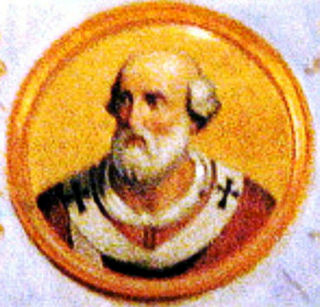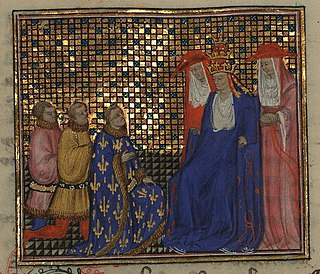 W
WAn antipope is a person who, in opposition to the legitimately elected pope, makes a significant attempt to occupy the position of Bishop of Rome and leader of the Catholic Church. At times between the 3rd and mid-15th centuries, antipopes were supported by important factions within the Church itself and by secular rulers.
 W
WAn antipope is a historical papal claimant not recognized as legitimate by the Catholic Church. Unlike papal tombs, the tombs of antipopes have generally not been preserved, with a few notable exceptions.
 W
WPeter of Candia, also known as Peter Phillarges, named as Alexander V, was a pope elected by the Council of Pisa during the Western Schism (1378–1417). He reigned briefly from June 26, 1409 to his death in 1410, in opposition to the Roman pope Gregory XII and the Avignon antipope Benedict XIII. In the 20th century, the Catholic Church reinterpreted the Western Schism by recognizing the Roman popes as legitimate. Gregory XII's reign was extended to 1415, and Alexander V is now regarded as an antipope.
 W
WDavid Allen Bawden, who takes the name "Pope Michael", is an American citizen and a conclavist claimant to the papacy. He stated in 2009 that he had approximately 30 "solid followers".
 W
WPedro Martínez de Luna y Pérez de Gotor, known as el Papa Luna in Spanish and Pope Luna in English, was an Aragonese nobleman, who as Benedict XIII, is considered an antipope by the Catholic Church.
 W
WChristopher claimed the papacy from October 903 to January 904. Although he was listed as a legitimate pope in most modern lists of popes until the first half of the 20th century, the apparently uncanonical method by which he obtained the papacy led to his being removed from the quasi-official roster of popes, the Annuario Pontificio. As such, he is now considered an antipope by the Catholic Church.
 W
WGuibert or Wibert of Ravenna was an Italian prelate, archbishop of Ravenna, who was elected pope in 1080 in opposition to Pope Gregory VII and took the name Clement III. Gregory was the leader of the movement in the church which opposed the traditional claim of European monarchs to control ecclesiastical appointments, and this was opposed by supporters of monarchical rights led by the Holy Roman Emperor. This led to the conflict known as the Investiture Controversy. Gregory was felt by many to have gone too far when he excommunicated the Holy Roman Emperor Henry IV and supported a rival claimant as emperor, and in 1080 the pro-imperial Synod of Brixen pronounced that Gregory was deposed and replaced as pope by Guibert.
 W
WRobert of Geneva, elected to the papacy as Clement VII by the cardinals who opposed Urban VI, was the first antipope residing in Avignon, France. His election led to the Western Schism.
 W
WGil Sánchez Muñoz y Carbón, was one of the antipopes of the Avignon Papacy, reigning from 10 June 1423 to 26 July 1429 as Clement VIII. He was born in Teruel between 1369–1370 and a member of the Avignon curia. When Alfonso V of Aragon reached an agreement with Pope Martin V, Sanchez Muñoz abdicated, made his submission and was appointed bishop of Mallorca. He died on 28 December 1446.
 W
WManuel Alonso Corral, known by his supporters as Pope Peter II, was the leader of the Palmarian Catholic Church, a mysticalist group not recognised by the Catholic Church, from 2005 to 2011.
 W
WClemente Domínguez y Gómez was a self-proclaimed successor of Pope Paul VI and was recognised as Pope Gregory XVII by supporters of the Palmarian Catholic Church schismatic breakaway movement in 1978. His claim was not taken seriously by other mainstream Catholics, the vast majority of whom were unaware of his existence.
 W
WAmadeus VIII was a Savoyard nobleman, the son of Amadeus VII, Count of Savoy and Bonne of Berry. He was nicknamed the Peaceful. After the death of his father in 1391, his mother acted as a regent, because of his youth. He was a claimant to the papacy from 1439 to 1449 as Felix V in opposition to Eugene IV and Nicholas V, and is considered the last historical antipope.
 W
WSergio María Ginés Jesús Hernández y Martínez, known by his religious name as Sergio María and by his papal name as Gregory XVIII, is the former pope of the Palmarian Catholic Church. Hernández was in office from 2011 until his 2016 resignation.
 W
WHippolytus of Rome was one of the most important second-third century Christian theologians, whose provenance, identity and corpus remain elusive to scholars and historians. Suggested communities include Palestine, Egypt, Anatolia, Rome and regions of the mideast. The best historians of literature in the ancient church, including Eusebius of Caesarea and Jerome, openly confess they cannot name where Hippolytus the biblical commentator and theologian served in leadership. They had read his works but did not possess evidence of his community. Photios I of Constantinople describes him in his Bibliotheca as a disciple of Irenaeus, who was said to be a disciple of Polycarp, and from the context of this passage it is supposed that he suggested that Hippolytus so styled himself. This assertion is doubtful. One older theory asserts he came into conflict with the popes of his time and seems to have headed a schismatic group as a rival to the bishop of Rome, thus becoming an antipope. In this view, he opposed the Roman Popes who softened the penitential system to accommodate the large number of new pagan converts. However, he was reconciled to the Church before he died as a martyr.
 W
WBaldassarre Cossa was Pisan antipope John XXIII (1410–1415) during the Western Schism. The Catholic Church regards him as an antipope, as he opposed Pope Gregory XII whom the Catholic Church now recognizes as the rightful successor of Saint Peter.
 W
WNicholas V, born Pietro Rainalducci was an antipope in Italy from 12 May 1328 to 25 July 1330 during the pontificate of Pope John XXII (1316–1334) at Avignon. He was the last antipope set up by a Holy Roman Emperor.
 W
WJoseph Odermatt, known by his religious name as Eliseo María and by his papal name as Peter III, is a Swiss Independent Catholic prelate and the current pope of the Palmarian Catholic Church. Odermatt succeeded Ginés Jesús Hernández after Hernández left the Palmarian Church and returned to the Roman Catholic Church.
 W
WLucian Pulvermacher was a traditionalist schismatic Roman Catholic priest and a modern-day antipope. He was the head of the "True Catholic Church", a small conclavist group that elected him Pope Pius XIII in Montana in October 1998. At the time of his death, he lived in Springdale, Washington, United States.